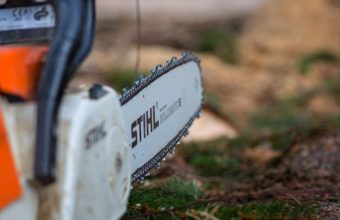Cutting down a tree in the most cost-effective manner requires balancing safety, legality, and the complexity of the task. Exercise caution when approaching tree removal, as it can pose significant risks.
Here are some strategies for reducing costs while ensuring the job is done safely and effectively…
- DIY (Do It Yourself) – If the tree is small and located in a safe area away from buildings, power lines, and other hazards, you might consider removing it yourself. This approach eliminates labor costs but requires you to have the necessary tools, safety equipment, and knowledge. Remember, safety is paramount, and this option should only be considered for very straightforward, low-risk situations.
- Borrow or Rent Equipment – If you decide to tackle the job yourself or with the help of friends, you may be able to borrow the necessary tools (chainsaws, ladders, safety gear) from friends or neighbors. Alternatively, renting equipment for a day can be more cost-effective than purchasing it outright.
- Local Government Programs – Some local governments offer tree removal programs, especially for trees that are dead, diseased, or pose a risk to public safety. Check with your local municipality to see if such programs exist and if your tree qualifies for removal at a reduced cost or for free.
- Group Discounts – If you have neighbors who also need tree removal services, you might be able to negotiate a group discount with a local tree service company. By bundling services, the company can save on travel and setup time, potentially passing those savings onto you.
- Off-Season Work – As mentioned earlier, tree service companies may offer lower rates during their off-peak seasons, typically late fall and winter. Scheduling your tree removal during these times can result in lower costs.
- Obtain Multiple Quotes – Prices can vary widely between companies. Obtain quotes from several tree removal services to compare rates. Be clear about what is included in the price, such as stump removal and debris cleanup, to ensure you’re making an accurate comparison.
- Minimal Service Request – If you’re capable of handling some aspects of the job yourself, such as debris cleanup and disposal, you can ask the tree service to only cut down the tree and leave the wood for you to deal with. This can reduce the cost significantly.
- Barter or Trade Services – If you have skills or services to offer, some small businesses or independent contractors might be willing to trade their tree removal services for something you can provide.
It’s crucial to prioritize safety above cost savings. If the tree is large, diseased, near power lines, or close to buildings, hiring professionals is advised. Always ensure that any service provider is insured and has the necessary qualifications and experience to safely remove the tree. Cutting corners on safety can result in injury, legal liability, and property damage, potentially costing far more than saving on the tree removal itself.






